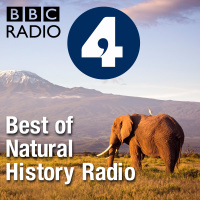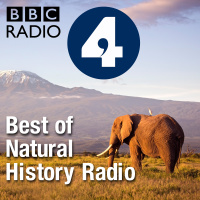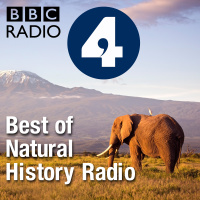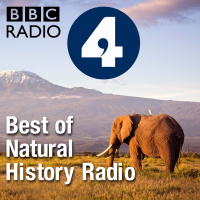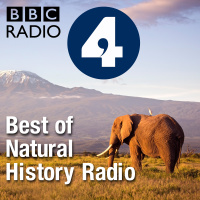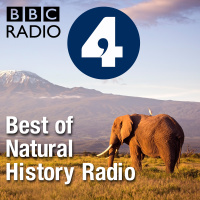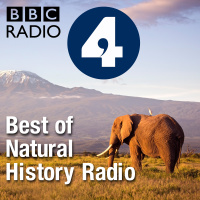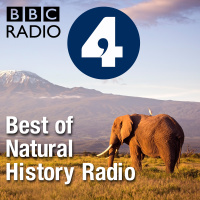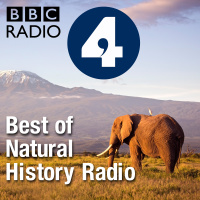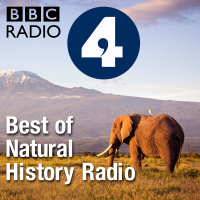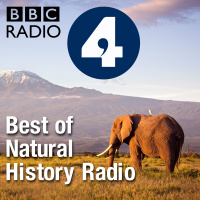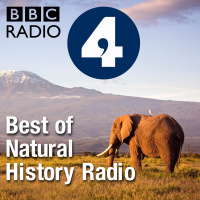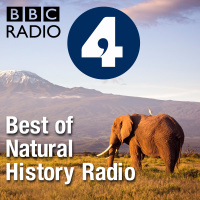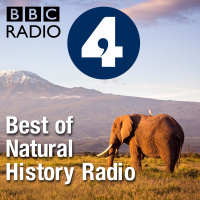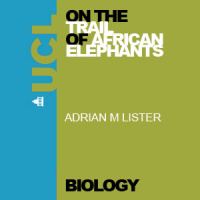Best Of Natural History Radio
- Autor: Vários
- Narrador: Vários
- Editor: Podcast
- Duración: 147:19:52
- Mas informaciones
Informações:
Sinopsis
The BBC Natural History Unit produces a wide range of programmes that aim to immerse a listener in the wonder, surprise and importance that nature has to offer.
Episodios
-
Living World : My Living World : Woodcock
22/03/2020 Duración: 21minWildlife filmmaker Hannah Stitfall and wildlife film researcher Dom Davies enjoy a close encounter with one of our most mysterious birds, the woodcock, when they review another selection from the LIVING WORLD archive. The woodcock is a wader which spends most of its life in woodland where its wonderful mottled plumage makes it very hard to see, especially as they are nocturnal so most active at night. The population swells in winter when over a million more migrate here from Scandinavia and Russia in search of earthworms and insects which they probe from the ground with their long bills. Hannah and Dom also discuss another remarkable feature of these birds which is their strange roding flight call.
-
Living World : My Living World : Winter Flies
10/03/2020 Duración: 21minWhere do flies go in winter and what happens to them? Wildlife filmmaker Hannah Stitfall and wildlife film researcher Billy Clark review another selection from the Living World archive to try and find out the answer. The original programme was recorded beside an icy pond in a woodland near Kidderminster where, with the help of pooters and ‘ghostbuster gear’, a surprising number of flies are discovered in winter including the stunning-looking dollies, best known for their metallic green sheen and long dancing legs!
-
Living World : My Living World : The Spined Loach
29/12/2019 Duración: 21minKeen naturalist Hannah Stitfall is joined by wildlife film researcher Dom Davies to review another programme from the LIVING WORLD archive. The subject today is Spined Loach - a fish you might never heard of because, whilst locally they are abundant, they are classified as a rare protected species and are only found in a handful of places in the UK. Also known as the Spotted Weather Loach because of their ability to detect changes in atmospheric or barometric pressure brought about by changes in the weather, they half bury themselves in fine organic sediment at the bottom of rivers or lakes during the day and then at night sieve the sediment, eating small shrimps and ejecting the mud and sand through their gills. As Hannah and Dom discover, these little fish also have some amazing survival techniques which enable them to survive low oxygen levels, whilst the spines which protrude from under their eyes are thought to help ward off predators.
-
Living World : My Living World : Jackdaw Roost
15/12/2019 Duración: 21minIn this episode from 2011 Joanna Pinnock wonders what makes jackdaws roost together, and to find out more heads to the Cambridgeshire countryside with corvid scientist Dr Alex Thornton. Arriving in the dead of night they await one of nature’s spectacles, of thousands of jackdaws simultaneously leaving their night roost in a cacophony of sound. It is one of those winter spectacles often overlooked but rivalling any in the natural world. So what is actually going on here? For Hannah and Billy this gives them the opportunity to discuss corvid activity. Science is beginning to unravel the biology and social intelligence of corvids, recently dubbed feathered apes, but there is a lot still to learn about these familiar if mysterious jackdaws. If the morning was a spectacle, how will that compare with the evening gathering at the roost; some roosts have been recorded in the Domesday Book and are still being used centuries later?
-
Natural Histories : Aye-Aye
29/11/2019 Duración: 27minThink sprite or hobgoblin and you are nearly there when it comes to the Aye-Aye, surely one of the weirdest looking creatures on earth? With its large saucer-like eyes, massive ears, and long skeletal middle finger which its uses to tap for grubs on logs, this lemur both fascinates and terrifies us. Endemic to the forests of Madagascar, some local people believe that if one looks at you, someone in your village will die. They even hang up an aye-aye on the edge of the village in some areas to ward off evil spirits. We are responsible for the demise of the aye-aye in other ways; by destroying the forests on which it depends. But as we hear, get up close to an aye-aye and you’ll meet one of the most alluring and watchable mammals on the planet. Not merely a creature in close harmony with its disappearing world, but as Brett Westwood and Verity Sharp discover an ambassador for conservation which still has us in its thrall.
-
Natural Histories : Pigeon
22/11/2019 Duración: 27minThe relationship between humans and pigeons is one of the oldest on the planet. They have been our co-workers; delivering messages, assisting during the war, providing a source of food, a sport and obsession for many, and a suitable religious sacrifice. They helped Darwin with his theory of Natural Selection, have become a powerful symbol of peace and helped us unravel some of the mysteries of navigation. Yet many of us still regard them as vermin, as “rats with wings”. Brett Westwood and Verity Sharp probe into this paradox, and explore how pigeons have helped us and what they can reveal about the homing instinct and what it means for us to feel at home
-
Natural Histories : Fern
15/11/2019 Duración: 27minFor a plant that we generally associate with shady, damp places, a plant that has no flowers or scent, the Fern has drawn us into her fronds and driven an obsession that is quite like any other. Pteridomania or Fern Madness swept through Victorian Britain in part thanks to the availability of plate glass from which manufacturers could build glass cases for growing ferns. The trade in ferns all but wiped out some species from parts of the UK and fern hawkers sold specimens on street corners in London. Brett Westwood and Verity Sharp trace our relationship with the fern on a journey from a slide of spores in Durham, to the art of Nature Printing via a garden fernery and discover that the fern is still weaving its magic spell over us.
-
Natural Histories : Poppy
08/11/2019 Duración: 27minPoppies are associated with many things but to most people they are a symbol of remembrance or associated with the opium trade. Natural Histories examines our fascination with the flower. Lia Leendertz visits the Royal Botanic Gardens Kew where James Wearn shows her a collection of poppy paraphernalia from around the world. Andrew Lack, of Oxford Brookes University and author of Poppy, explains how the flower made its way to the British Isles with the introduction of agriculture, and Joe Crawford of Exeter University describes the popularity of the opium poppy in 19th century Britain, especially among female poets. A vibrant opium trade led British horticulturalists to try and establish a home grown opium crop - without success. Fiona Stafford appraises the poppy in art encouraging us to look again at Monet's late 19th century painting of a poppy field in northern France. It was painted just a few decades before the outbreak of the Great War which established the red poppy as a permanent reminder of the blood
-
Natural Histories : Chicken
01/11/2019 Duración: 27minHow did we get from the gorgeous red junglefowl scratching away in the jungles of south-east Asia to the chicken now eaten in its millions? Brett Westwood and Joanna Pinnock trace the trail. The story's told by Greger Larson, Director of the Palaeogenomics & Bio-Archaeology Research Network; Annie Potts, Director, New Zealand Centre for Human-Animal Studies; Dr Joanne Edgar, University of Bristol School of Veterinary Sciences and by a visit to meet real red junglefowl, the original chicken, at the Pheasantry at Sudeley Castle in Gloucestershire.
-
Natural Histories : Bee
25/10/2019 Duración: 27minBees have been the subject of fascination and reverence since ancient times. Natural Histories explores the story of bees and why humans like to compare themselves to them, seeing ourselves as either virtuous workers or moral examples. The ancient Greek poets thought of themselves as bees who foraged and chose the sweetest words to produce great art, while the Victorians admired bees for their industry and selflessness. But with news of declining bee populations around the world, Natural Histories talks to those who monitor the decline of some species and try to address the ecological problems causing their demise, as well as to honeybee keepers who say that in the cities, bees are actually thriving.
-
Natural Histories : Sloth
18/10/2019 Duración: 27minThe dreamy smile of the sloth has made it wildly popular, but once its slowness was condemned and saw it named after one of the seven deadly sins. Brett Westwood and Joanna Pinnock talk to those who really know, understand and live with sloths and ask if we're still projecting our own feelings onto them. Our changing attitudes to sloths tell us more about ourselves than about this harmless animal. Dr Rebecca Cliffe, founder of the Sloth Conservation Foundation and a leading researcher, is in the rainforest in Costa Rica with them right now. She describes how local people feel about them, while she sits under a tree with a sloth at the top. Joanna Pinnock tries for her own encounter with Marilyn the sloth and her baby Elio at ZSL London Zoo, and experiences the magic of sloths at first hand. William Hartston, author of Sloths: A Celebration of the World’s Most Misunderstood Mammal. explains the vexed history of sloth first as a sin then its next incarnation as a harmless South American treetop dweller named af
-
Living World : My Living World : Stone Curlew
13/10/2019 Duración: 21minWildlife film maker Hannah Stitfall is joined by Dom Davies, a wildlife film researcher to discuss another pick from the Living World archive. Today their subject is Stone Curlews and a programme in which the presenter Joanna Pinnock travels to Wiltshire in search of these crepuscular waders whose haunting calls can be heard after dusk. She is joined by Nick Adams of the RSPB who has been working with local farmers on a conservation project to improve the habitat for these birds and restore the population which became seriously depleted in the mid-1980s. For Hannah and Dom the programme offers a rare encounter with a bird that few of us will have seen or heard.
-
Living World : My Living World : Winter Ladybirds
29/09/2019 Duración: 21minZoologist and wildlife film maker Hannah Stitfall is joined by Billy Clark, a researcher with the BBC Natural History Unit to discuss another selection from the LIVING WORLD archive. Today the subject is over-wintering ladybirds and the challenges these most familiar of insects face during dormancy. They also discuss the origin of the name 'Ladybird', the diverse range of species we have, threats from an alien species and a ladybird survey that is looking for your help.
-
Planet Puffin. Episode 12: The Puffin Rescuers
29/07/2019 Duración: 17minIn the final episode, Becky Ripley and Emily Knight search for pufflings that have run into trouble on their journey from their burrows to the sea, guided by the light of the moon.
-
Planet Puffin. Episode 11 Leaving the Nest
15/07/2019 Duración: 15minThe season is ending. Becky Ripley and Emily Knight go in search of the last pufflings left in the burrows on the Isle of May to give them a quick check-up before the birds leave their family homes and head out to sea.
-
Planet Puffin. Episode 10: Puffin Decoys
08/07/2019 Duración: 08minHow do you draw puffins to an island they abandoned long ago? Emily Knight and Rebecca Ripley are on Ramsey Island off the west coast of Wales. Here they're trying a very loud solution - blasting out the sound of puffins, from boom bass speakers.
-
Planet Puffin. Episode 9: Nuffin' Like a Puffin
07/07/2019 Duración: 06minEmily Knight and Rebecca Ripley are taking a break from the island in this episode, If you think puffins are just small penguins, Warhorse author Sir Michael Morpurgo is here to tell you how wrong you are in this tale of how Puffin Books led him to love the birds.
-
Planet Puffin. Episode 8: The Plastic Problem
01/07/2019 Duración: 17minBecky Ripley and Emily Knight find the Isle of May's beaches awash with plastic waste and discover its not just plastic we can see that is damaging, but tiny fragments shed from our clothes too.
-
Planet Puffin. Episode 7: Beyond Cuteness
01/07/2019 Duración: 05minThis week Emily and Becky take a break from the Isle of May. In their absence, award-winning author Adam Nicolson presents a rich, visual piece of writing that celebrates the real puffin that's there to be seen when you look past the looks.
-
Planet Puffin. Episode 6: Netting Puffins
01/07/2019 Duración: 11minBecky Ripley and Emily Knight return to the Isle of May, where they string up a giant net to catch puffins as they fly past. When the fish in their beaks are sent flying, they go running to gather them up in the name of science.


